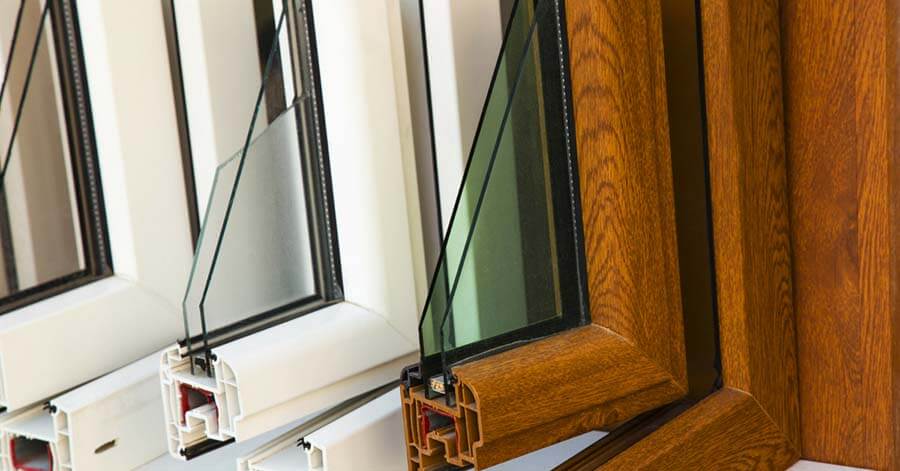Types of Window Replacement and Energy Efficient Replacement Windows
Energy-efficient window replacement basics (2023)

Windows are an essential part of any building as they provide natural light and ventilation while offering protection against the elements. However, not all replacement windows are created equal, and some are more energy-efficient than others. In this article, we will discuss the different types of windows and how energy-efficient windows can help you save money on your energy bills when you are planning on a window replacement project.
Double Hung Replacement Windows
A double-hung window is a type of window that has two movable sashes, one on the top and one on the bottom. Both sashes can be opened or closed independently, allowing for better control of ventilation and air flow. These windows are one of the most popular styles in homes and buildings because they are versatile and can be used in a variety of settings.
The construction of a double hung window consists of a frame that holds the two sashes in place. The sashes can be moved up and down by sliding them along a track, which is typically located on the sides of the frame. The sashes are counterbalanced by weights, springs, or other mechanisms to make them easy to operate. Double hung windows have been used for centuries and are popular for their classic look and functionality. They are commonly found in traditional homes, but can also be used in contemporary settings with the right materials and design. They are available in a variety of sizes, styles, and materials, including wood, vinyl, fiberglass, and aluminum.
One of the primary benefits of double hung windows is their versatility. Because both sashes can be moved up or down, they can be adjusted to allow in just the right amount of air and light. This makes them ideal for rooms that need good ventilation and natural light, such as kitchens and bathrooms. Additionally, they can be used in areas where space is limited, such as above kitchen counters or in small bathrooms. Another benefit of double hung windows is their ease of maintenance. Because both sashes can be moved, it’s easy to clean both the inside and outside of the window. This makes them a popular choice for homeowners who want windows that are easy to care for.
Replacement Casement Windows
Casement windows are a type of window that is hinged on one side and opens outward like a door. They are known for their simplicity, functionality, and energy efficiency. Casement windows have been used for centuries and are popular in both traditional and contemporary homes. The construction of a casement window consists of a frame that holds a single sash in place. The sash is hinged on one side and can be opened or closed by turning a crank or handle. When the window is closed, it provides a tight seal, which helps to prevent air and water from entering the home.
Casement windows are available in a variety of sizes, styles, and materials, including wood, vinyl, fiberglass, and aluminum. Wood windows are popular for their classic look and can be painted or stained to match the style of the home. Vinyl and fiberglass windows are durable and low-maintenance, making them a popular choice for homeowners who want windows that are easy to care for. Aluminum windows are also available and are known for their strength and durability.
One of the primary benefits of casement windows is their energy efficiency. When the window is closed, it provides a tight seal that helps to prevent air from leaking in or out. This can help to reduce energy costs by keeping the indoor temperature comfortable and preventing drafts. Another benefit of casement windows is their ease of use. The window can be opened or closed with a simple crank or handle, which makes them a popular choice for homeowners who want windows that are easy to operate. Additionally, because the window opens outward, it provides unobstructed views and allows for maximum airflow.
Sliding Replacement Windows
Sliding windows are a type of window that has one or more sashes that slide horizontally along the window frame. They are known for their simplicity, functionality, and contemporary style. Sliding windows are popular in modern homes and buildings. The construction of a sliding window consists of a frame that holds one or more sashes in place. The sashes are mounted on rollers or tracks and can be easily slid open or closed. Sliding windows are typically made of materials such as wood, vinyl, fiberglass, or aluminum.
One of the primary benefits of sliding windows is their ease of use. The window can be easily opened or closed by sliding the sash along the track, which makes them a popular choice for homeowners who want windows that are easy to operate. Additionally, sliding windows are ideal for areas where space is limited, as they don’t take up any space when opened. Sliding windows also provide good insulation, which can help reduce energy costs. The sashes create a tight seal when closed, which helps to prevent drafts and keep the indoor temperature comfortable. Additionally, many sliding windows are available with energy-efficient features such as low-e glass, which can further reduce energy costs.
Replacement Picture Windows
Picture windows are a type of window that is designed to provide an unobstructed view of the outside. They are known for their simplicity, functionality, and ability to let in natural light. Picture windows are popular in modern homes and buildings.
The construction of a picture window consists of a single large pane of glass that is fixed in place and cannot be opened. The window is typically framed with wood, vinyl, fiberglass, or aluminum. Picture windows are available in a variety of sizes and shapes, including square, rectangular, and circular. One of the primary benefits of picture windows is their ability to let in natural light and provide an unobstructed view of the outside. Because the window is a single large pane of glass, it doesn’t have any mullions or grids that can obstruct the view. Additionally, because the window cannot be opened, it provides a tight seal that helps to prevent air from leaking in or out.
Picture windows are also available with energy-efficient features such as low-e glass, which can help to reduce energy costs by keeping the indoor temperature comfortable and preventing drafts. Additionally, because picture windows don’t have any moving parts, they are easy to maintain and require very little upkeep.
Bow and Bay Replacement Windows
Bow and bay windows are two types of windows that are known for their unique design and functionality. Both types of windows are popular in traditional and contemporary homes and buildings.
Bay windows are a series of three or more windows that are installed together in a curved or angled shape. They are typically made up of one large picture window in the center with two smaller windows on either side. The windows are typically angled outward, which creates additional space and adds visual interest to the room. Bay windows are popular for their ability to let in natural light and provide an unobstructed view of the outside.
Bow windows are similar to bay windows but are made up of four or more windows that are installed together in a curved shape. The windows are typically installed at a sharper angle than bay windows, which creates a more rounded look. Bow windows are popular for their ability to add space and light to a room, as well as their unique style. Both bow and bay windows are available in a variety of materials, including wood, vinyl, fiberglass, and aluminum. They are also available with energy-efficient features such as low-e glass, which can help to reduce energy costs and keep the indoor temperature comfortable.
Energy Efficient Windows
Energy efficient window replacement projects are meant to reduce heat loss and gain, which can significantly reduce your energy bills. Below we will go over some of the types of windows and benefits of installing energy efficient windows.
Installation and Maintenance of Replacement Windows
Proper installation and maintenance are essential to ensure the energy efficiency of your windows. Here are some tips:
Hire a professional installer who is experienced in installing energy-efficient windows.
Seal any gaps or leaks around the window frame.
Clean and maintain your windows regularly to ensure optimal performance.
Types of Energy Efficient Windows
- Low-E Glass Windows: These windows have a special coating that reflects heat, reducing the amount of heat that enters or escapes your home. Low-E Glass works not only to reflect UV rays, but by reflecting heat it supports the argon or krypton gas within the panes of glass, allowing them to work at their peak performance for much longer.
- Gas-Filled Windows: These windows have argon or krypton gas between the panes, which reduces heat transfer. Argon and krypton gas are naturally occurring gasses that are simply concentrated between the window panes to provide a dense insulator that you can still see through.
- Double- or Triple-Pane Windows: These windows have two or three panes of glass with a layer of gas or air in between, which provides better insulation. Double pane replacement windows are the standard for modern homes, however nothing compares to triple pane glass replacement windows in terms of energy efficiency.
- Insulated Frames: These frames have insulation material between the frame and the wall, which reduces heat transfer.
Benefits of Energy Efficient Windows
- Lower Energy Bills: Energy efficient windows can reduce your heating and cooling costs quite substantially – ultimately, the amount that your energy bills are reduced by installing replacement windows depends on many factors: the type of windows that are being removed and replaced and the type of insulation in your attic and siding have major affects on these results.
- Improved Comfort: have you ever been sitting in your living room and notice an annoying draft? Energy efficient windows help maintain a more consistent temperature in your home, reducing drafts and hot or cold spots.
- Reduced Condensation: Energy efficient windows can reduce condensation, which can lead to mold and mildew growth.
Factors That Affect Energy Efficiency
Several factors go into measuring how energy efficient your window replacement is:
- U-Factor: This measures the rate at which windows transfer heat.
- Solar Heat Gain Coefficient (SHGC): This measures the heat that enters through the window.
- Air Leakage: This measures the air that leaks through the window.
Conclusion
In conclusion, windows are an essential part of any building, and there are many types of windows to choose from, each with its unique benefits. Energy-efficient windows can help you save money on your energy bills and improve the comfort of your home. When choosing windows, consider factors such as energy efficiency, style, and cost, and hire a professional installer to ensure proper installation and maintenance.
At Odyssey Home Remodeling, we have partnered with Provia windows to offer our customers in Wisconsin, Illinois, and Indiana the option of installing some of the highest quality and most energy efficient replacement windows on the market.
Questions About Energy-Efficient Windows
- What is the most energy-efficient type of window?
The most energy-efficient type of window is a triple-pane window with low-e glass and a gas fill. However, this type of window can be expensive, so it’s important to weigh the cost against the potential energy savings.
- How much can I save on my energy bills with energy-efficient windows?
The amount you can save on your energy bills will depend on factors such as your location, the size of your home, and your heating and cooling usage. On average, energy-efficient windows can reduce your energy bills by up to 30%.
- Are energy-efficient windows more expensive than regular windows?
Energy-efficient windows can be more expensive than regular windows, but they can also provide significant cost savings in the long run. When choosing windows, consider the upfront cost, as well as the potential energy savings over time.
- Can I install energy-efficient windows myself, or should I hire a professional?
While it’s possible to install windows yourself, it’s recommended that you hire a professional installer who is experienced in installing energy-efficient windows. Proper installation is essential to ensure optimal energy efficiency and performance.
- How often should I clean and maintain my energy-efficient windows?
It’s recommended that you clean your windows at least twice a year, or more often if you live in an area with a lot of dust or pollution. Regular maintenance, such as lubricating the tracks and hinges, can also help ensure optimal performance and energy efficiency.


